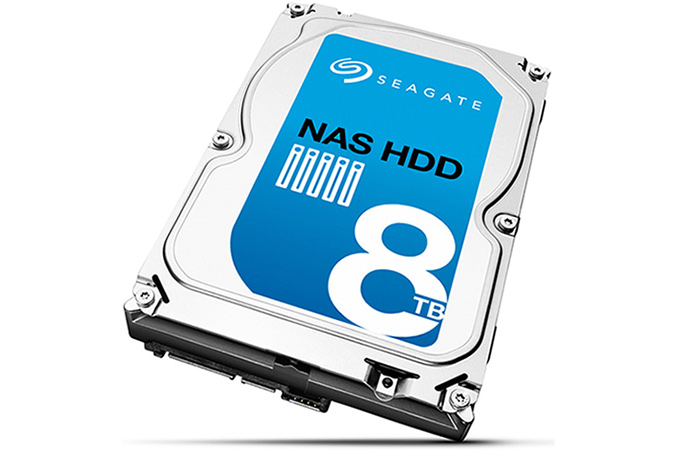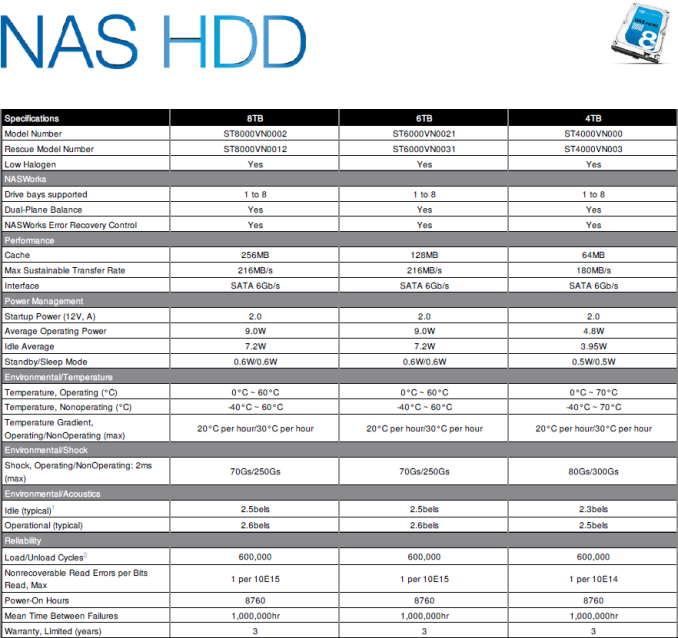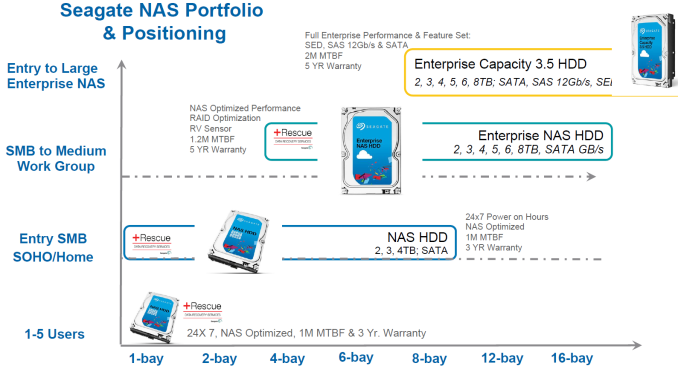Seagate Introduces First 8 TB Hard Disk Drive for Consumer NAS Applications
by Anton Shilov on January 12, 2016 7:05 PM EST
Seagate Technology on Tuesday introduced its new breed of hard disk drives (HDDs) for network area storage (NAS) and RAID applications. The new family of NAS HDDs from Seagate includes a model with 8 TB capacity, which is the industry’s first hard drive of such kind that is targeted towards small and medium businesses as well as personal use, i.e, 1-8 bay NAS units.
Seagate’s 8 TB 3.5-inch NAS HDD is based on six perpendicular magnetic recording (PMR) platters with 1.33 TB capacity each. The hard drive features 7200 revolutions per minute spindle speed, 256 MB DRAM cache as well as a Serial ATA interface. The manufacturer declares 216 MB/s maximum sustainable media to cache transfer rate, which is considerably higher compared to previous-generation drives. The new HDD have average operating power of 9 W as well as average idle power of 7.2 W.
Seagate’s latest family of NAS HDDs also includes models with 6 TB, 4 TB, 3 TB, 2 TB and 1 TB capacities. Hard drives with 6 TB and 8 TB capacities have spindle speed of 7200 RPM, whereas the remaining drives feature 5900 RPM speed.
High-capacity PMR platters, 7200 RPM spindle speed as well as massive 256 MB DRAM cache will help the new 6TB and 8 TB drives to offer very high random read performance, which should be useful not only for NAS environments, but for desktops as well.
Previously Seagate offered 8 TB drives for archive/nearline, enterprise capacity and enterprise NAS applications. Such drives are optimized for servers, racks, maximum reliability, etc., which comes at a price. The new 8 TB HDD for small and medium businesses (SMBs) as well as creative professionals are designed for tower enclosures with one to eight bays and are essentially the first hard drives with such capacity that are optimized for desktop applications. The drives are also fully compatible with select NAS products from companies like ASUSTOR, QNAP, Synology and Thecus.
Hard disk drives for SMB NAS applications use platforms that were developed to handle additional vibration, hence, they are more reliable than desktop-class HDDs, but are less advanced that enterprise-class hard drives. NAS HDDs usually feature dual plane balance control, improved heads as well as special firmware.
Seagate’s NAS HDDs compete against Western Digital’s WD Red lineup. At present, the maximum capacity offered by the WD Red is 6 TB, hence, with 8 TB offerings Seagate will have a competitive advantage over its rival when it comes to NAS hard drives.
The new Seagate NAS HDD 8TB has shipped to select customers. Wide-scale availability is expected at the end of the Q1 2016. Consumers should be on the lookout for the ST8000VN0002 or ST8000VN0012 models, as they are the PMR ones. Seagate also has a ST8000VN000 model which uses host-aware SMR (shingled magnetic recording).The MSRP of the new 8TB PMR NAS HDD from Seagate will be $385 when it ships later this quarter.
Source: Seagate


















38 Comments
View All Comments
DanNeely - Wednesday, January 13, 2016 - link
It's about time *SOMEONE* updated their rated numbers for prosumer HDDs. The non-occurence of the RAID apocalypse over the last few years means that real world number have been much higher than the number on the specsheet; but the clearly fantasy numbers - presumably picked by bean counters to avoid losing money from warranty claims based on higher URE rates in marginal drives - have made realistic risk assessment impossible.Nenad - Wednesday, January 13, 2016 - link
Actually, 10E14 means one error per 12TB I think ( since it is 1 in 1e14 BITs, so need to divide by 8 for BYTEs).And current 10E15 means one error per 125TB, or about 15 drive reads, which still is not exactly great ;p
Nenad - Wednesday, January 13, 2016 - link
Ah, and on their 4TB HDD they have "only" 10e14, which means error in about 3 drive reads - definitely not great.Luckily, modern NASes like Synology support btrfs (beta) or QNAP support ZFS, so that could reduce issues with bit-errors ;p
edzieba - Wednesday, January 13, 2016 - link
You're right, I derped and used the bit error rat as a byte error rate. So everything is 8x worse. Stop using RAID5 already!extide - Wednesday, January 13, 2016 - link
I noticed that as well. Good to see. I'll still stick with ZFS and 2 or 3 drive parity, though.Ian Cutress - Wednesday, January 13, 2016 - link
The problem with perception of failure rates on consumer drives is vibration. Most drives have official failure rates and warranties when they're individual drives in a system. The minute you put two near each other, or say four/eight in a NAS, depending on the chassis in most situations the drives will continually vibrate due to spinning. Professional grade drives are built to withstand a multi-HDD environment, whereas if you design a drive to be on its own, it can be made a lot, lot cheaper. So when a major storage firm says '20% failure rate' and you realize they're putting 48 consumer drives in a 4U chassis, I want to say 'no duh'. The fact that other drives can withstand it better is perhaps a nod to base level quality, but ultimately if you want a multi-drive or NAS environment, make sure what you purchased is actually built for it.LordanSS - Wednesday, January 13, 2016 - link
Many consumer cases come with anti-vibration HDD caddies, by either using rubber dampers or similar.I know my old (and now retired) CM690-II had their removable drive caddies set up in that way.
Wouldn't something of the sort lessen vibration issues on a multi-HDD setup?
Reflex - Wednesday, January 13, 2016 - link
Thank you for this post, Ian. Most people are referring to the Backblaze reliability report when they make claims about reliability, but they fail to recognize that Backblaze has not taken the steps necessary to make their metrics scientific or meaningful beyond their own environment. That includes aspects like what you mention, but also no real effort to randomly sample their sources, or make certain that they have statistically significant sample sizes of the drives they test, nor make certain that the environment is actually the same for each drive being included in the results.At best, their results may help them make decisions for their own storage, but honestly given the lack of control for variables I don't know how useful it is even in that context.
ZeDestructor - Wednesday, January 13, 2016 - link
And all of that is a completely moot point, since other drives, like the consumer HGST, WD Reds and even Seagate's own later 4TB drives all have much better (lower) failure rates than a certain ST3000DM001. Sometimes you have a dud design, and from how the other drives behave, it's pretty clear the ST3000DM001 is one such case.Reflex - Thursday, January 14, 2016 - link
True or not, citing Backblaze is not making a case.